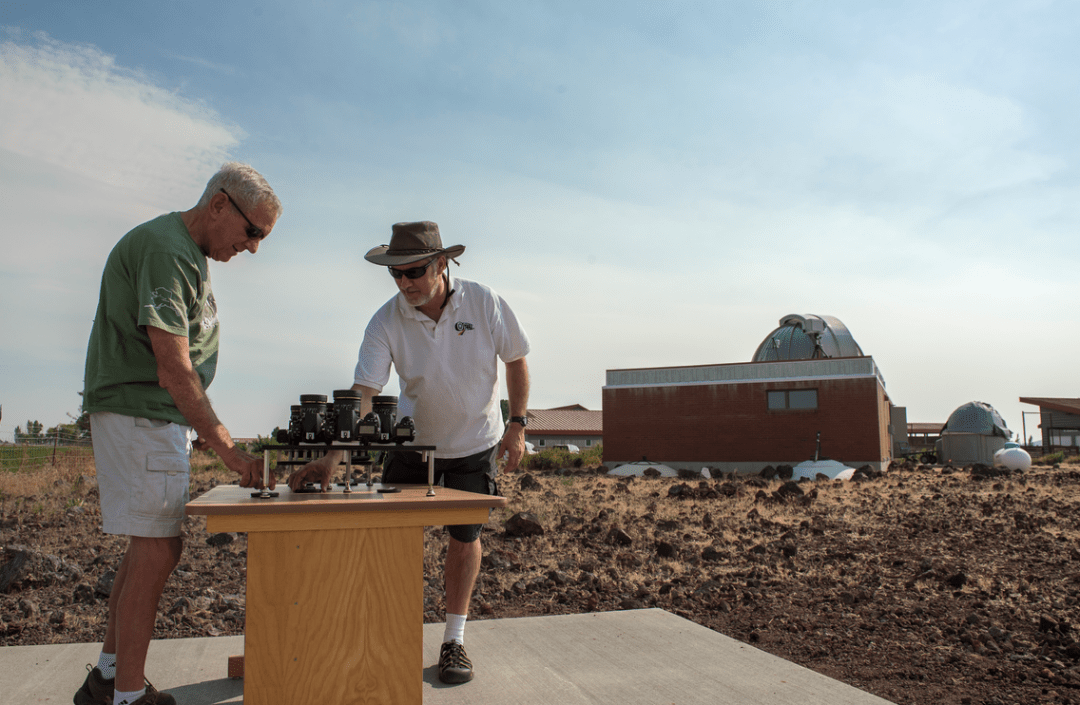MSU father/son duo tackles decades-old eclipse question

Millions of people flocked to the 70-mile-wide path of the 2017 total solar eclipse to get a glimpse of the perfectly obscured sun, but Montana State University professor Joe Shaw and his father, Glenn Shaw, went there to answer a decades-old riddle.
The implications of the riddle - really a somewhat obscure scientific question - are more important today than in 1973, when Glenn traveled to Kenya to document a total solar eclipse that crossed Africa.
In the scorching desert, with lions roaring at sunset, he and his colleagues “trained and trained and trained” for their experiment for two weeks, Glenn recalled recently. Their primary objective was to measure how dark the sky got during the eclipse and to compare that to his mathematical models.
“I just thought it would make an interesting experiment,” said Glenn, who earned his bachelor’s in electrical engineering at MSU in 1963 and went on to become a professor of physics at the University of Alaska - Fairbanks.
When the eclipse finally came, the scientists used special motor-driven cameras to scan the sky, and found that it was about 10,000 times darker than during a normal day, which agreed with their predictions. They also measured the sky’s polarization and were surprised to find that it changed remarkably during the eclipse.
Polarization occurs when waves of light are aligned. The same scattering of light that causes the sky to be blue also polarizes light to varying degrees in different parts of the sky. Polarization cannot be discerned with the naked eye, although sunglasses and camera lenses make use of the phenomenon to reduce glare. Glenn’s experiment was the first time that anyone had ever measured the changes in polarization across the entire sky during a total solar eclipse.
“He’s pretty well-known as the guy who pointed out that sky polarization during an eclipse is symmetric about the zenith,” said Joe, a professor in the Department of Electrical and Computer Engineering in the College of Engineering.
“Symmetric about the zenith” looks like rings concentric around the center of the sky. Normally, polarization is more linear, a gradient from east to west. The change could be partially explained by Glenn’s models. But “his measurements showed a slight asymmetry,” Joe said. The rings were slightly higher on one side. That became the riddle.
Glenn and others had theories about what caused the anomaly: the reflectance of a nearby lake; the effects of distant clouds; the sky changing while the scans slowly happened. But nobody provided a definitive answer, in part because total eclipses are relatively rare, occurring somewhere on the planet only every one to three years.
Meanwhile, Joe developed a specialty in atmospheric optics and advanced his own research at MSU. Over time, his work converged on polarization, which was becoming increasingly important for detecting satellites and spacecraft too small to otherwise see, among other things.
“If you’re on Earth looking at a satellite in space, you have to look through the sky,” he said. To do that reliably, “the polarization that exists in the atmosphere has to be understood, it has to be predictable.”
In 2008, he made very accurate measurements of normal, daytime sky polarization from the Mauna Loa volcano in Hawaii. The results, which suggested that the reflective properties of the volcano’s lava fields had influenced the polarization measurements, brought him face-to-face with the same questions that Glenn’s 1973 experiment had raised.
Not long after that, Joe started thinking about the 2017 eclipse and talking with Glenn about answering that riddle once and for all.
“Other people had looked at this issue but nobody had made a good set of measurements with all the supporting data,” such as ground reflectance and cloud distribution, he said.
Their goal would be to make the most well-documented measurements of the sky during a total eclipse using new, powerful cameras that Joe had developed at MSU. “We have many capabilities that (Glenn) didn’t have,” he said.
After four years of preparation, their plan came to fruition on Aug. 21, 2017 in Rexburg, Idaho, where Joe and Glenn together measured the polarization of the sky using both a replica of Glenn’s scanning system as well as the new all-sky imagers. And they were joined by four MSU graduate students and three undergrads from Brigham Young University’s Rexburg campus. Another undergraduate student from Colorado State University had helped develop the camera systems, but was unable to join the team in Idaho.
“We know enough now to know that it was a big success,” Joe said after the eclipse.
So, has the riddle been answered?
“I don’t have the final answer yet, but I’m very excited about what we’re seeing,” Joe said. The team will analyze the data in the coming months.
But he’s increasingly confident saying that the asymmetry that Glenn measured was caused in part by the limitations of his equipment. As the eclipse’s shadow swept across the Earth during the 1973 eclipse, the sky polarization was changing while the camera was making its scans.
With the specialized optics that his team developed for the darkness of the eclipse, Joe is now dreaming up new experiments to measure polarization in the nighttime sky, which perhaps would create new questions for researchers to answer in coming decades.
“Everything we’ve been doing in the daytime, we can start doing at night,” he said. “Nobody has ever done that. This whole world opens up to us now.”